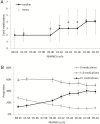Polypharmacy Among Adults Aged 65 Years and Older in the United States: 1988-2010
- PMID: 25733718
- PMCID: PMC4573668
- DOI: 10.1093/gerona/glv013
Polypharmacy Among Adults Aged 65 Years and Older in the United States: 1988-2010
Abstract
Background: Older adults frequently have several chronic health conditions which require multiple medications. We illustrated trends in prescription medication use over 20 years in the United States, and described characteristics of older adults using multiple medications in 2009-2010.
Methods: Participants included 13,869 adults aged 65 years and older in the National Health & Nutrition Examination Survey (1988-2010). Prescription medication use was verified by medication containers. Potentially inappropriate medications were defined by the 2003 Beers Criteria.
Results: Between 1988 and 2010 the median number of prescription medications used among adults aged 65 and older doubled from 2 to 4, and the proportion taking ≥5 medications tripled from 12.8% (95% confidence interval: 11.1, 14.8) to 39.0% (35.8, 42.3).These increases were driven, in part, by rising use of cardioprotective and antidepressant medications. Use of potentially inappropriate medications decreased from 28.2% (25.5, 31.0) to 15.1% (13.2, 17.3) between 1988 and 2010. Higher medication use was associated with higher prevalence of functional limitation, activities of daily living limitation, and confusion/memory problems in 2009-2010, although these associations did not remain after adjustment for covariates. In multivariable models, older age, number of chronic conditions, and annual health care visits were associated with increased odds of using both 1-4 and ≥5 medications. Additionally, body mass index, higher income-poverty ratio, former smoking, and non-black non-white race were associated with use of ≥5 medications.
Conclusions: Prescription medication use increased dramatically among older adults between 1988 and 2010. Contemporary older adults on multiple medications have worse health status compared with those on less medications, and appear to be a vulnerable population.
Keywords: Cardiovascular; Depression; Functional performance; Medication; Public health.
© The Author 2015. Published by Oxford University Press on behalf of The Gerontological Society of America. All rights reserved. For permissions, please e-mail: journals.permissions@oup.com.
Figures

References
-
- Hajjar E, Cafiero A, Hanlon J. Polypharmacy in elderly patients. Am J Geriatr Pharmacother. 2007;5:345–351. 10.1016/j.amjopharm. 2007.12.002 - PubMed
-
- Gurwitz JH. Polypharmacy: a new paradigm for quality drug therapy in the elderly? Arch Intern Med. 2004;164:1957–1959. 10.1001/archinte.164.18.1957 - PubMed
-
- Goulding MR. Inappropriate medication prescribing for elderly ambulatory care patients. Arch Intern Med. 2004;164:305–312. 10.1001/archinte.164.3.305 - PubMed
-
- Zhan C, Sangl J, Bierman AS, et al. Potentially inappropriate medication use in the community-dwelling elderly: findings from the 1996 Medical Expenditure Panel Survey. JAMA. 2001;286:2823–2829. 10.1001/jama.286.22.2823 - PubMed
Publication types
MeSH terms
Grants and funding
LinkOut - more resources
Full Text Sources
Other Literature Sources
Medical

